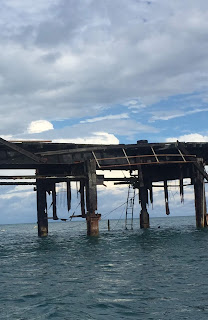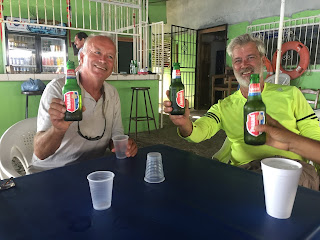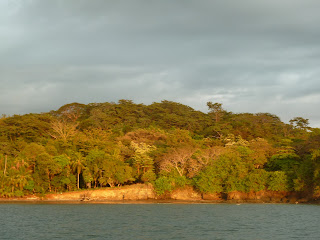Leaving
Golfito and crossing the border into Panama by sea requires traveling around a
long pointed peninsula. As with most marine headlands there are currents and
winds to contend with.
Aside
from the odd passing rain squall we have not had much in the way of wind and
the passage into Panama was light airs. The currents around Punta Burica were a
different story. As we headed south we found ourselves in a strong tidal rip
that behaves like a permanent gyre. A gyre is a big whirl-pool that accumulates
floating debris. We were trying to keep a good lookout, but floaty
stuff often hides waterlogged and semi-submerged. This makes it darned hard to
see no matter how closely you are watching. Greg was at the nav station
chatting on the radio and Alice had just popped below to grab a drink when
there was a loudish thunky bump. What was that? blurted out Greg. A millisecond
later the boat lurched with a WHAM!
We
were both back on deck in a flash and slammed the throttle arm to neutral, but
the boat was already dead in the water. Looking over the side we could see we
had run into a great big ugly floating log and we had ridden right up on top of
it. Taking a hard clunk at sea is never a good thing and our worry index was
experiencing a sharp spike. It didn’t appear that any debris was near the propeller, so Greg backed the boat down off the log and we could now get a good
look what we had whacked: it was three feet in diameter and about 30 feet long.
A nasty rotting log that had been in the water for years.
A
quick check of the keel bolts showed no leaks and there was no water entering
from the bow. The only thing to do was to don mask and snorkel and have a
look-see at the bottom for a damage check. Fear and loathing of potential damage was made creepier
by the deep murky water and the presence of a lot of fish swimming around the boat.
Greg gets freaked out for some reason when swimming in deep water offshore. The feeling is of being a prey animal in the presence of predator fish, so the swim was kept
as short as was reasonable to carry out a damage assessment. Amazingly, though
it felt like a really hard thump, there was no apparent damage. The knot-meter
spinner had scooped up some rotten wood as it passed over the rotten log, but other than that there was not even
a scratch on the bottom.
We
had gotten lucky. The bow must have hit the log on the upwards part of a wave
and then the boat rode up the log, slowing the boat down as it pushed the log
down into the water. When the forward edge of our keel root reached the log it suddenly stopped the boat altogether. Hitting the log,
even though it was a big one, was not near as bad as striking a no-give bottom rock. The keel root in our boat is extremely strong, so
aside from the trauma of Greg having nearly swallowed his ass-hole in the first moments after
the strike, all proved well in the end. We carried on at slow motoring speed
until we cleared the rip tide zone and tried to calm our shaken nerves.
Rounding
the corner into Panamanian waters we spent a night anchored on the roadstead
before carrying on in the morning to Puerto Armuelles for check-in. Latin-America is well-known for its officious ways. Panama is
obviously very proud of that heritage and the paperwork they issue to their
officials for visiting boaters puts them in the top echelons of human
bureaucratic endeavour.
The man in uniform was Reinaldo
Omar Barrantes N., Oficial de Abordaje. Luckily he
was friendly. A kind and solicitous man, he did almost all the paperwork for
us, painstakingly completing each form in careful penmanship - pressing hard
through 6 carbon copies. Afterwards he sheparded us through 3 additional
offices, each with their own assortment of additional forms to sign, stamp and
issue. The paperwork took all day. We were able to take a break after 3 hours
for some shopping and to take lunch before returning at 4pm to receive the
final document, our cruising permit. As the sun set we found ourselves lighter
some USD $275 in fees. But we were richer a thick sheaf of officially issued
stamped papers. Possession of these papers produced a strong feeling of officially approved relaxation while we enjoyed our nightly sundowner and contemplated our
day’s work .
Isla
Parida is 30 miles from Armuelles and was our destination for the morning after
check in. The passage was uneventful and we spent four nights at Parida, making
a circle around the island, checking out all its lovely anchorages and
snorkeling while we explored. Despite a hard introduction, western Panama has
proven to be another place favourite. More on that when we next post.
An overnight anchored on the 'shelf' at Punta Balsa, Panama.
The pier at Armuelles, Panama.
Consider our options: i) climb the rusty ladder to the condemned pier or ii) a dingy beach landing. We chose the dingy beach landing because the surf was low.
Who is Lucy?
Friendly official from the port captain's office.
It was a welcome change to have the Port Captain, Immigration, Customs, the Quarantine office and the Merchant Marine office all on the same street corner.
Celebrating Panama arrival at the best restaurant in town.
Lots of choice in seafood. Mackerel, Shrimp, Squid, Octopus, and Snapper (not listed). Chicken and pork chops for the not seafood inclined.
Lovely beach walk back to the boats after our meal.
Lots of things falling apart in Armuelles.
Drying out the kite while sailing on the way to Isla Parida.
Lovely anchorages at Parida.
The fishermen living on Isla Parida brought us 4 lobster that we shared with Rob and Debra on Chinese New Year.
Satisfied and relaxed after a swim.
Wolf on Del Sur joins us.

























No comments:
Post a Comment